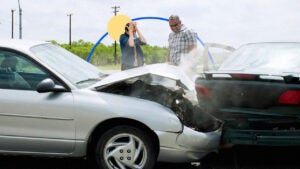Gap insurance in California: How it works and how much it costs

Key takeaways
- Gap insurance — short for guaranteed asset protection insurance — is specifically designed for drivers with outstanding loan balances on their vehicles.
- It is typically only available for brand-new vehicles or for models that are less than three years old.
- Gap insurance is different from new car replacement coverage.
- It is typically more expensive to purchase gap insurance from a dealership than on your own from an insurer.
Did you know your new car lost about 10 percent of its value the second you drove it off the lot? Within three years, it may depreciate by as much as half. If your vehicle gets stolen or totaled in an accident, your insurance company will base your compensation off of its current value. And yet you’re still obligated to pay off the full balance on your car loan — even if insurance doesn’t cover all of it. Gap insurance can help you handle this cost. Bankrate breaks down how this type of insurance for new vehicles could help you avoid large out-of-pocket expenses in the Golden State.
What is gap insurance?
Gap coverage helps pay the difference between what you owe on your auto loan and the payout you receive from your insurer if your vehicle is stolen or rendered a total loss. While it does fill in a financial gap, that is not where this coverage gets its name — it actually stands for “guaranteed asset protection.”
It’s easiest to understand gap insurance with an example. Let’s say you used a $25,000 auto loan to purchase a new vehicle, and you carry a full coverage car insurance policy. Your vehicle is stolen from your driveway, and you file a claim with your insurance provider. Your insurer, however, factors depreciation into your claim payout and only gives you $20,000. In this instance, gap insurance could help cover the remaining $5,000 you owe on your auto loan.
Typically, gap insurance is only available for brand-new vehicles or for models that are less than three years old. Without gap insurance, your car insurance company is not concerned about the outstanding balance on your auto loan. If you’re planning on financing most or all of your vehicle purchase, gap insurance could be an important safeguard. If you make a substantial down payment, you may have less risk of being upside down on your loan and needing this type of insurance.
How does gap insurance work in California?
Gap insurance in California is generally an option to purchase if:
- You are the original loan or lease holder on a new vehicle purchase
- You have both collision and comprehensive coverage
- The vehicle is less than two to three model years old
Gap coverage is commonly confused with new car replacement coverage, but they are different. Gap coverage is a way to financially protect yourself if you have an outstanding loan on your vehicle and experience a total loss. New car replacement, on the other hand, helps drivers obtain a new version of their damaged vehicle’s make and model after a total loss. Gap insurance does not pertain to purchasing a new vehicle.
When do you use gap insurance?
In insurance terms, a total loss occurs when the cost to repair your vehicle exceeds its depreciated value (also known as actual cash value or ACV). This might happen if your vehicle is:
- Destroyed by a fallen tree
- Totaled in an accident
- Stolen and never recovered
- Inoperative due to complete engine failure
If your vehicle is deemed a total loss and the insurance payout is not enough to cover your outstanding loan balance, gap insurance can help. Remember, gap insurance is only for total losses, though. It does not help with smaller repairs or routine maintenance. For instance, if you run a stop sign and get hit but your car is only somewhat damaged, gap coverage would not apply. However, if you have collision insurance, that can help pay for repairs in this instance.
Gap insurance vs other coverage options
Many types of car insurance can offer financial protection for the investment you’ve made in your vehicle. However, each coverage type pertains to specific situations, and it can be difficult to keep them all straight. In the table below you can see how gap insurance works in California, along with comprehensive and collision coverage.
| Gap insurance | Comprehensive | Collision | |
|---|---|---|---|
| What it covers | Only covers your car if it is deemed a total loss. Only pays the difference between the depreciated value and your remaining loan balance. | Pays for damage if your car is damaged by something other than a collision. Covers events like fire, wind, falling objects, vandalism, theft or flood waters. | Covers damage sustained to your car from colliding with another vehicle or object, such as a sign, fence or tree. |
| Who offers it | Many insurance companies offer it but may call it “loan/lease coverage.” Dealerships also sell gap insurance in California. | Comprehensive coverage is offered by most, if not all, insurance companies. | Collision coverage is offered by most, if not all, insurance companies. |
Where to buy gap insurance in California
While shopping, you may hear California gap insurance referred to as loan/lease coverage. Many — but not all — major insurers write gap insurance policies. For example, Geico, one of the largest auto insurance companies in California, does not.
If you’re buying a new car from a dealership, you might be offered gap insurance before you finalize your purchase. However, most insurance professionals do not recommend purchasing gap insurance at a dealership. Not only does it usually cost more up front than a gap insurance policy from a regular insurer would, gap insurance from a car dealership is usually added to your auto loan, which means you’d pay interest on it.
Gap insurance companies in California
Luckily, many car insurance companies are also gap insurance companies. If you’re wondering where to buy gap insurance, the list of providers below can be a good place to start:
- Progressive: National insurance company that offers many types of insurance. Gap coverage can be found under loan/lease coverage.
- Allstate: As the fourth largest auto insurer in the U.S., it offers several add-on coverage options and numerous discounts to potentially offset your monthly insurance premium.
- Nationwide: Offers multiple usage-based programs, where customers’ driving habits are factored into their rates.
- AAA: Regional clubs offer their members varying levels of coverage, but California drivers can purchase gap insurance. Membership in a local club is required.
- State Farm: National insurance company that doesn’t technically offer gap insurance but has a Payoff Protector program for cars financed by State Farm Bank.
The California government enacted a law in 2023 that introduced more oversight and regulation on the sale of gap insurance within California. The goal was to reduce unreasonable financial burdens on consumers and decrease the potentially predatory nature of some gap insurance offerings. Specifically, the bill aimed to address “problematic market practices, including where GAP waivers are excessively expensive, of questionable value, are not properly refunded or not properly explained to consumers.”
This law is meant to reduce consumer risk by requiring more disclosure from gap insurance sellers and placing restrictions on selling gap insurance that covers less than 70 percent of the vehicle’s value. The law also prohibits mandatory gap insurance requirements as a term of financing.
Frequently asked questions
Why we ask for feedback Your feedback helps us improve our content and services. It takes less than a minute to complete.
Your responses are anonymous and will only be used for improving our website.
You may also like

Can I get a loan with a 550 credit score?

Can you refinance Sallie Mae student loans?

What is full coverage car insurance?



